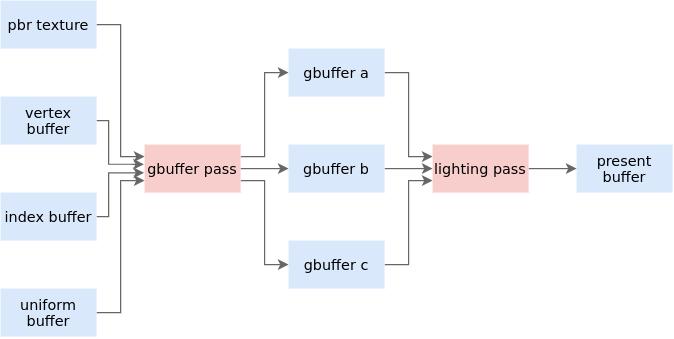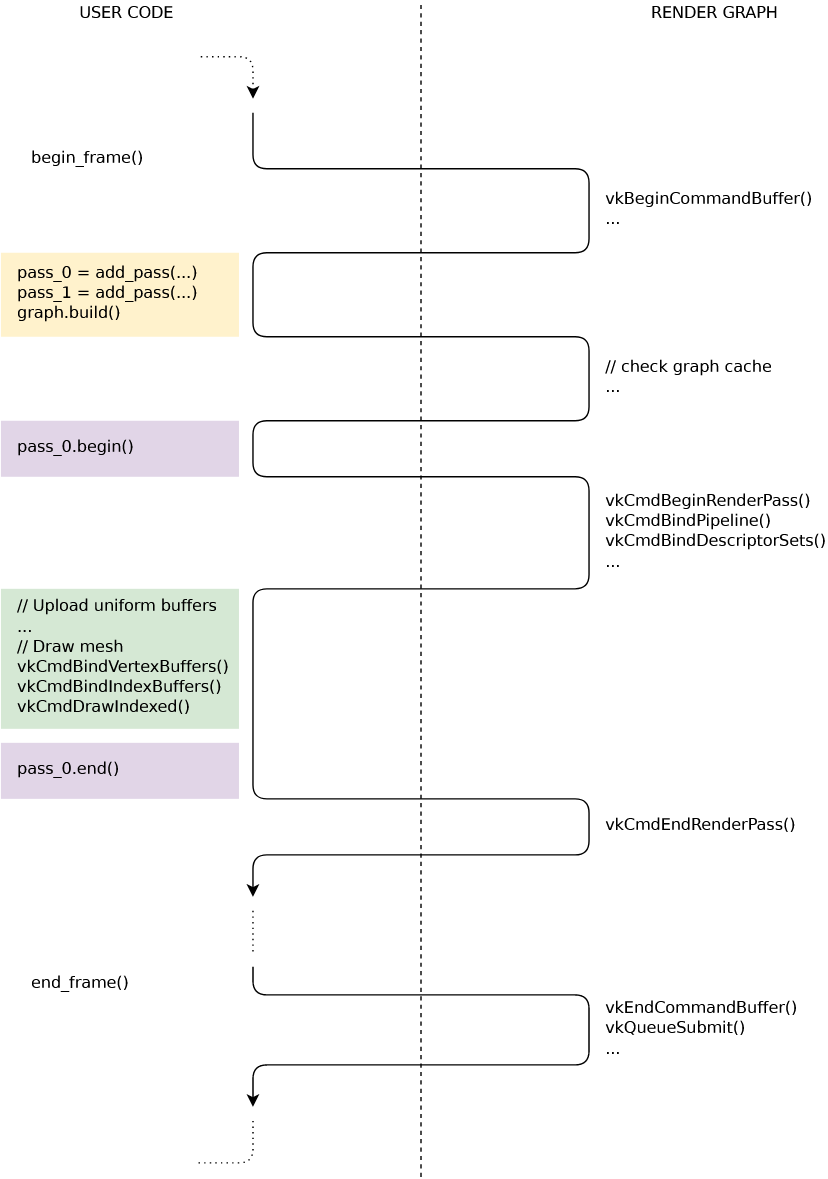This article is my attempt to document my experimental render graph project, called graphene. Graphene is still in flux, and I do not have a crystal clear roadmap ahead of me, only loose goals. It is scary to publish something when I don’t have the full picture yet. However, documentation is best written fresh, so I will write what comes to mind now, and edit later if required. I might write more articles later if I have more to talk about. Here’s what I have so far:
What is a render graph?
You can think of the process of rendering as a bipartite graph. This means that there are two sets of things, and an element of one set can only be connected to an element of the other. Build systems can also be thought of as bipartite graphs, as explained in The Success and Failure of Ninja by Evan Martin.

In the case of rendering, the two sets are resources and passes. Passes represent execution of shaders, with a given pipeline state. Pipeline state is things like blend modes, depth testing, viewport, etc. Passes consume and produce resources, which are buffers or images.
This is basically a render graph.
I think it’s interesting to develop an API around this abstraction. I’m far from the first person looking at this problem, FrameGraph: Extensible Rendering Architecture in Frostbite [Video, Slides] by Yuriy O’Donnell. Halcyon + Vulkan [PDF] by Graham Wihlidal. Unreal Engine RDG 101. but I have a few personal goals in mind:
Goals
- Support rendering to the screen, to a probe, or to disk with near-identical code.
- Keep the API low-level enough to allow arbitrary production and consumption of buffers and images.
Non-goals
- Target only Vulkan, without multi-API ambitions.
- Don’t do pass-reordering and profile-guided optimization to maximize GPU occupancy. This is interesting, but out of scope.
- Don’t publish as a crate, at least for now. The idea of a microkernel-style engine is appealing to me, but this project does not aim to be a thin render graph library. It is more of a research framework.
- Game studios often want custom graphics, but have to modify an off-the-shelf engine to do so. This costs them money, because every single engine upgrade requires manual merging of in-house engine modifications. Render graphs provide an opportunity to minimize the footprint of engine changes. While this is interesting, don’t pursue it in this project.
Now let’s have a look at some specifics:
Immediate mode vs retained mode
There is a fundamental tension between graphics developers, and newer GPU APIs like Vulkan, Metal or DirectX 12:
The APIs want to front-load everything. Every aspect of pipeline state—which images to render to, which buffers to consume, whether the depth test is enabled, whether blending is enabled, which shaders to execute—all should be declared up-front. At run-time, you can avoid expensive validation checks, and dispatch to the GPU as fast as possible.
Graphics developers (although I can’t speak for everyone) want to specify logic in the render loop. That way, they can toggle effects individually for gameplay or debug visualization.
Thus, loosely speaking, APIs want to be retained mode, but graphics developers want to be immediate mode. Render graphs are a good way to resolve this tension.
Graph declaration, invocation, and dispatch
There are three steps to working with a render graph:
- Declaration: This is where you add passes and specify pipeline state for each pass you intend to render.
- Invocation: This is where you begin or end passes. Because you declare all of your passes before you start invoking them, the graph knows what’s coming, and can optimize accordingly.
- Dispatch: This is where you make draw calls or compute shader dispatches. The render graph doesn’t know or care about this part, but it’s the part that the graphics developer arguably cares the most about.
The Unreal Engine 4 graph API looks roughly like this:
// Declaration
FRDGBuilder graph(cmd_buf);
graph.add_pass(
...
// Dispatch
[pass_0_params, shader_0](cmd_buf) {
... // Draw calls or compute dispatches
}
);
// Declaration
graph.add_pass(
...
// Dispatch
[pass_1_params, shader_1](cmd_buf) {
... // Draw calls or compute dispatches
}
);
// Invocation
graph.execute(); </div>Here, the dispatches are lambdas. When the user calls graph.execute(), each pass begins, its lambda is called, and then it ends.
Lambdas tend to play fast and loose with lifetimes. In C++ you basically assume that the captured state is valid and accessible in the lambda. Rust is much stricter, and this style of API gets too hairy.
Instead, I’ve found that this tends to work a lot better:
// Declaration
let pass_0 = graph.add_pass(...);
let pass_1 = graph.add_pass(...);
graph.build();
// Invocation
pass_0.begin();
// Dispatch
... // Draw calls or compute dispatches
// Invocation
pass_0.end();
pass_1.begin();
// Dispatch
... // Draw calls or compute dispatches
// Invocation
pass_1.end();There are no lambdas here. Code runs in the same order that it’s written in, and lifetimes become very straightforward.
Let’s look at the anatomy of a frame in this API:

begin_frame()clears a command buffer and appends a begin command to it.
- Then we declare the graph. As passes are added, we store this information in a simple array.
- When
graph.build()is called, we hash the array of passes and check if we already have a cached graph with the same hash. If we don’t, then we construct a new one. Graph construction is expensive, but only happens on application init, on window resize, on shader hot-reload, or if the rendering logic is changed.
pass.begin()andpass.end()append render pass instructions and pipeline state changes to the command buffer. Pipeline barriers also may get inserted here.
- Between the pass begin and end, the graphics developer appends draw commands and dispatches to the command buffer.
- Finally,
end_frame()ends the command buffer and sends it to the GPU to be executed.
That’s basically it.
Side-note: I had an idea of using Rust’s async/await features to build a render graph. Since that feature also internally builds a directed graph, there is some semantic overlap. I asked around, and found out that there already was a working implementation of this idea! rendertoy by Tomasz Stachowiak. After going through the code, I decided that the complexity of async/await wasn’t worth it for me, for this project.
My API is not without its demerits, though: Each pass has to be declared once, and then invoked once. This is a little extra boilerplate. Probably most painfully, it requires that the passes be declared and invoked in the same order, but does nothing to enforce this at compile-time. If you have any thoughts, please get in touch.
Future work
Going forward I want to implement the following features. I might have something to say about them later:
- Layout transitions: Inserting barriers automatically to transition resources between passes.
- Resource aliasing/reuse: Intermediate buffers and images can share the same backing memory, if their usage doesn’t overlap. This saves GPU global memory, without the user having to manage this manually.
- Interframe resources: Temporal effects rely on persistent buffers and images. I need to figure out how this fits into the API.
- Async compute: Vulkan has a separate compute queue. I need to figure out how to implement proper compute support.
- Automatic subpasses for tiled architectures: It might be interesting to conflate subsequent passes into Vulkan subpasses, under certain conditions. This will make a big difference on GPUs with tiled architectures—e.g. mobile GPUs—where this will avoid redundant transfer of memory.